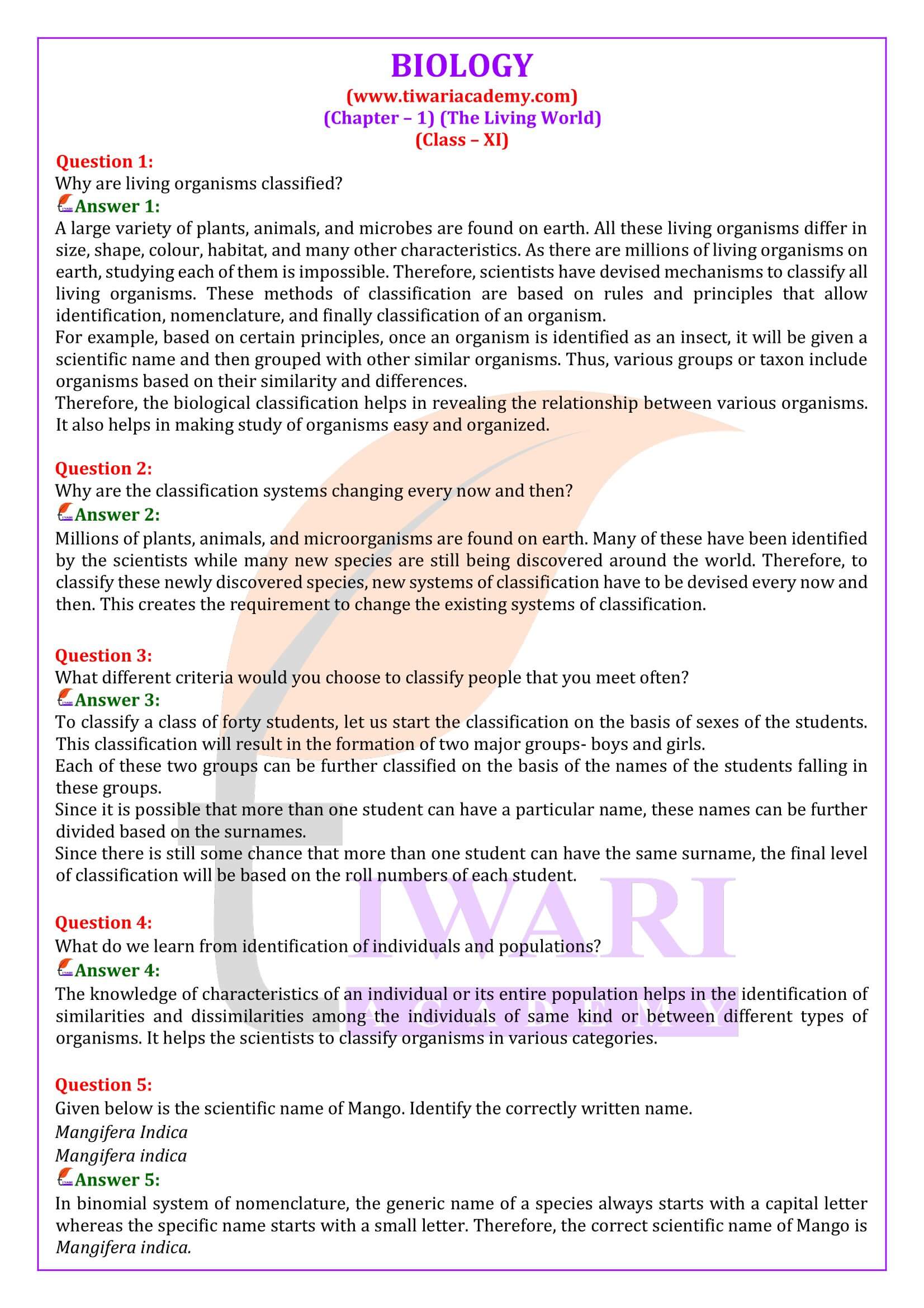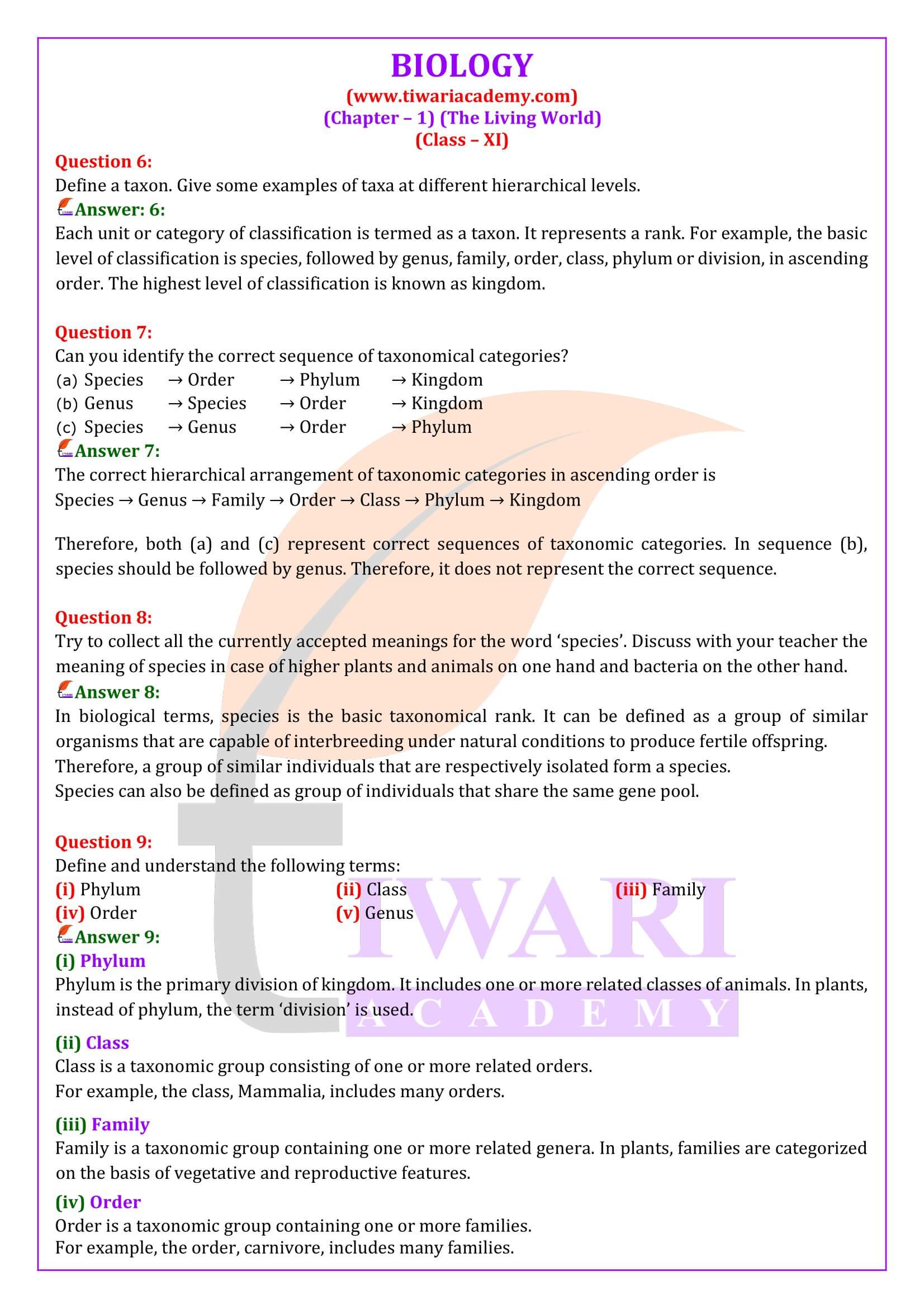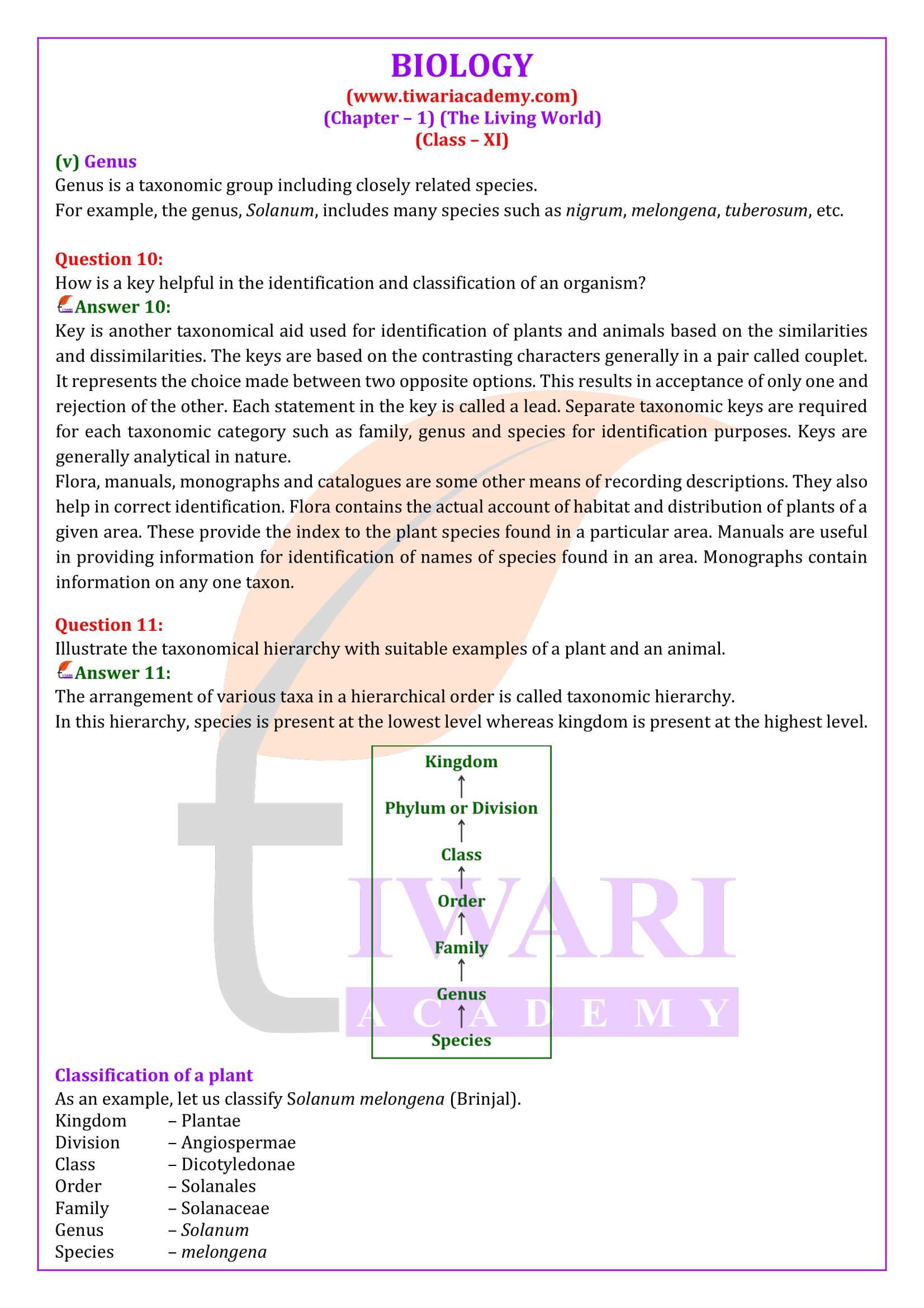NCERT Solutions for Class 11 Biology Chapter 1 The Living World in Hindi and English Medium to Study online or download in PDF format free updated for new academic session 2024-25. Solutions are applicable for boards like UP, MP, CBSE Boards, etc, who are following NCERT Books as course books.
NCERT Solutions for Class 11 Biology Chapter 1
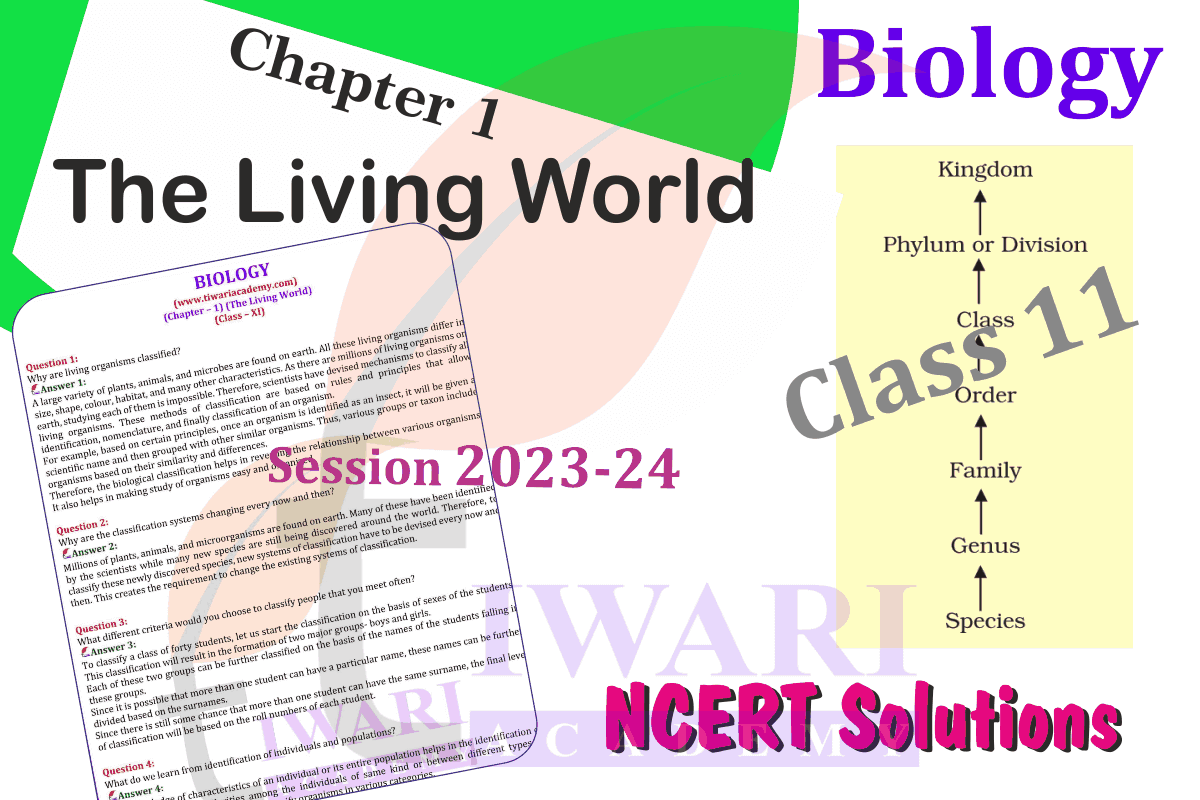
| Class: 11 | Biology |
| Chapter 1: | The Living World |
| Content: | NCERT Exercise Solutions |
| Session: | CBSE 2024-25 |
| Medium: | Hindi and English Medium |
Class 11 Biology Chapter 1 Solutions in English
NCERT Solutions for Class 11 Biology Chapter 1 is given below to free download in PDF format updated for new academic session 2024-25. CBSE Offline Apps based on latest NCERT Books following the new CBSE Syllabus are given to download in PDF form. Join the discussion forum to ask your doubts.
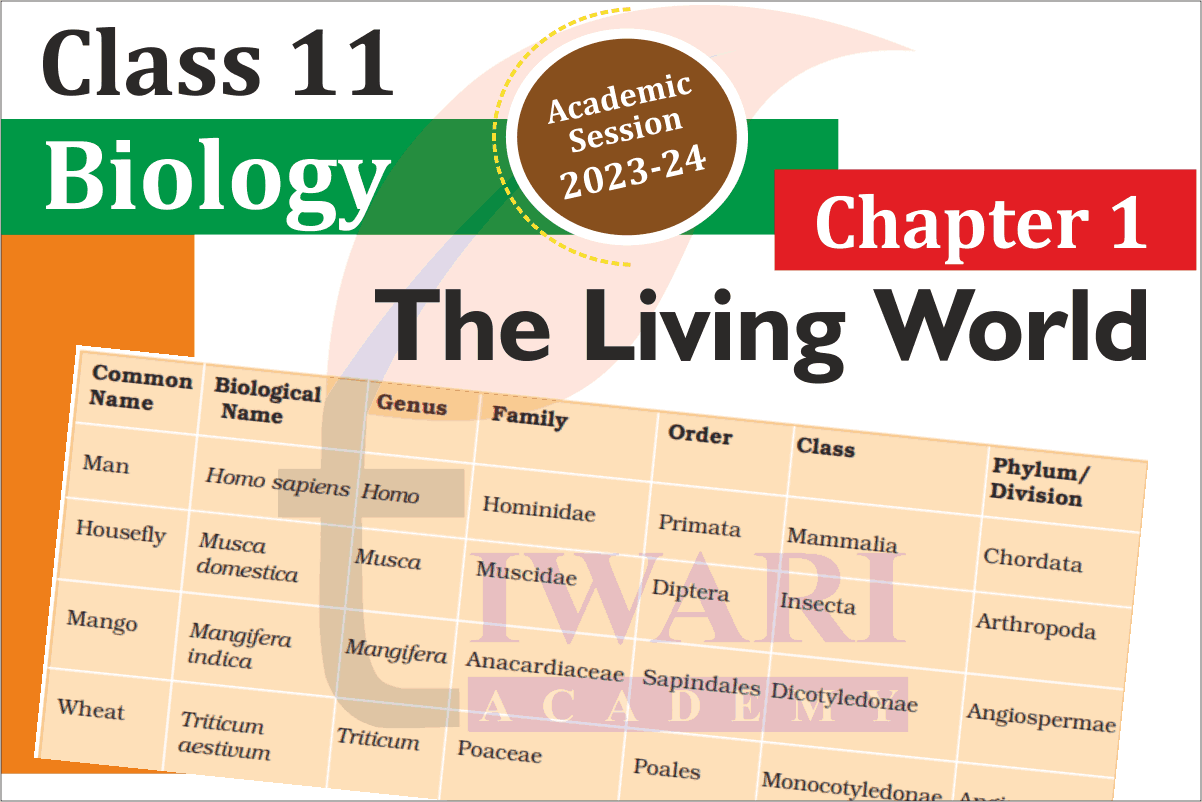
Important Terms related to Chapter 1
1. Biodiversity: Term used to refer to the variety of microorganisms, plant and animals on earth.
2. Need for classification: To organise the vast number of microorganisms, plants and animals into categories that could be named, remembered, studied and understood.
3. Three Domains of Life: Proposed by Carl Woese in 1990 who also proposed the six kingdom classification for living organisms. The three Domains of life are Archaea, Bacteria and Eukarya.
4. Taxonomy: Study of principles and procedures of identification, nomenclature and classification.
5. Systematics: It deals with classification of organisms based on their diversities and relationships among them. Terms was proposed by Carolus Linnaeus who wrote ‘Systema Naturae’.
Kingdom → Phylum /Division → Class → Order → Family → Genus → Species.
BINOMIAL NOMENCLATURE
1. Binomial Nomenclature: Given by Carolus Linnaeus. Each scientific name has two components-Generic name + Specific epithet.
2. Rule for Nomenclature:
Latinised names are used.
First word is genus, second word is species name. Printed in italics; if handwritten then underlined separately. First word starts with capital letter while species name written in small letter.
3. ICBN: International Code for Botanical Nomenclature (for giving scientific name to plants.)
4. ICZN: International Code of Zoological Nomenclature (for giving scientific name to animals.)
5. Zoological Parks (Places where wild animals are kept in protected environment under human care) Example: National Zoological Park, Delhi.
6. Herbarium Store house of dried, pressed and preserved plant specimen on sheets, kept systematically according to a widely accepted system of classification, for future use.
Scientific names of some organisms
1. Man → Homo sapiens
2. Housefly → Musca domestica
3. Mango → Mangifera indica
4. Wheat → Triticum aestivum
Concept of Species
All the members that can interbreed among themselves and can produce fertile offsprings are the members of same species. This is the biological concept of species proposed by Mayr.
Taxa: Each category (i.e., unit) of classification is called as a taxon.
Taxonomic Hierarchy: Classification of organisms in a definite sequence of taxon or category or rank in a descending order.
Important Questions on 11th Biology Chapter 1
Why are living organisms classified?
A large variety of plants, animals, and microbes are found on earth. All these living organisms differ in size, shape, colour, habitat, and many other characteristics. As there are millions of living organisms on earth, studying each of them is impossible. Therefore, scientists have devised mechanisms to classify all living organisms. These methods of classification are based on rules and principles that allow identification, nomenclature, and finally classification of an organism. For example, based on certain principles, once an organism is identified as an insect, it will be given a scientific name and then grouped with other similar organisms. Thus, various groups or taxon include organisms based on their similarity and differences. Therefore, the biological classification helps in revealing the relationship between various organisms. It also helps in making study of organisms easy and organized.
Why are the classification systems changing every now and then?
Millions of plants, animals, and microorganisms are found on earth. Many of these have been identified by the scientists while many new species are still being discovered around the world. Therefore, to classify these newly discovered species, new systems of classification have to be devised every now and then. This creates the requirement to change the existing systems of classification.
What different criteria would you choose to classify people that you meet often?
To classify a class of forty students, let us start the classification on the basis of sexes of the students. This classification will result in the formation of two major groups- boys and girls. Each of these two groups can be further classified on the basis of the names of the students falling in these groups. Since it is possible that more than one student can have a particular name, these names can be further divided based on the surnames. Since there is still some chance that more than one student can have the same surname, the final level of classification will be based on the roll numbers of each student.
What do we learn from identification of individuals and populations?
The knowledge of characteristics of an individual or its entire population helps in the identification of similarities and dissimilarities among the individuals of same kind or between different types of organisms. It helps the scientists to classify organisms in various categories.
Given below is the scientific name of Mango. Identify the correctly written name. Mangifera Indica Mangifera indica
In binomial system of nomenclature, the generic name of a species always starts with a capital letter whereas the specific name starts with a small letter. Therefore, the correct scientific name of Mango is Mangifera indica.
Define a taxon. Give some examples of taxa at different hierarchical levels.
Each unit or category of classification is termed as a taxon. It represents a rank. For example, the basic level of classification is species, followed by genus, family, order, class, phylum or division, in ascending order. The highest level of classification is known as kingdom.
Try to collect all the currently accepted meanings for the word ‘species’. Discuss with your teacher the meaning of species in case of higher plants and animals on one hand and bacteria on the other hand.
In biological terms, species is the basic taxonomical rank. It can be defined as a group of similar organisms that are capable of interbreeding under natural conditions to produce fertile offspring. Therefore, a group of similar individuals that are respectively isolated form a species. Species can also be defined as group of individuals that share the same gene pool.
How is a key helpful in the identification and classification of an organism?
Key is another taxonomical aid used for identification of plants and animals based on the similarities and dissimilarities. The keys are based on the contrasting characters generally in a pair called couplet. It represents the choice made between two opposite options. This results in acceptance of only one and rejection of the other. Each statement in the key is called a lead. Separate taxonomic keys are required for each taxonomic category such as family, genus and species for identification purposes. Keys are generally analytical in nature. Flora, manuals, monographs and catalogues are some other means of recording descriptions. They also help in correct identification. Flora contains the actual account of habitat and distribution of plants of a given area. These provide the index to the plant species found in a particular area. Manuals are useful in providing information for identification of names of species found in an area. Monographs contain information on any one taxon.
NCERT Solutions for Class 11 Biology Chapter 1 The Living World
Download NCERT Solutions for Class 11 Biology Chapter 1 The Living World in PDF form free to use offline or visit to online view options to use it online. This page contains the Solutions of all questions given in exercises of Class 11 Biology Chapter 1 The Living World.
